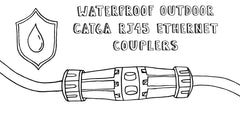Payment methods accepted

Top 5 Advantages of Fiber Optic Cable
Written by Ben Hamlitsch, trueCABLE Technical and Product Innovation Manager RCDD, FOI
There are many advantages when it comes to using fiber optic cable in your telecommunications infrastructure. By the early 1990’s, as the internet was becoming popular in the public realm, fiber optic cabling started to be laid around the world. There was a big push to wire the world in order to provide infrastructure to help with the perceived problems that many believed we would face when Y2K hit.
Since then, fiber has been present in virtually every nation on the earth forming the backbone of the modern communications infrastructure.
Fiber Optic cabling has been installed all over the world replacing copper cabling for many reasons, including its ability to carry signals over exceptionally long distances with minimal attenuation, or loss. Fiber Optic cables are also immune to electromagnetic interference; unlike the copper wires they are increasingly replacing.
Fiber Optics are primarily used as the backbone of the modern telecommunications grid. The advent of Fiber Optics allowed for universal broadband internet access for homes and businesses around the world.
During the early days of the commercial internet, hundreds of thousands of kilometers of fiber optic cables were laid, most of which is still not in use (known as Dark Fiber). That mass of fiber optic cable is credited with the rise of India and China as major technological powers because it allows thousands of individual entrepreneurs to find or create employment for themselves serving clients in other countries thousands of kilometers away.
But what is it that gives Fiber Optics the advantage over the traditional copper cabling? Lets dig into 5 of the advantages Fiber Optics has over the competition.
Bandwidth
What is Bandwidth? Bandwidth describes the maximum data transfer rate of the network or internet connection. It measures how much data can be sent over a specific connection in a given amount of time.
When it comes to bandwidth, fiber optics comes in at number 1. First, Fiber Optics travel close to the speed of light. After all, light is used to transmit data over fiber optics.
What is the speed of light? The Speed of light travels 186,000 miles/sec or (300,000 km/sec) in a vacuum which is the fastest that anything can travel.
If we look at fiber transmission as the speed of photons (light) versus the speed of electrons, Photons travel at the speed of light, whereas electrons (used in copper) travel at less than one percent of the speed of light.
Although fiber optic cables do not reach the speed of light, they are only about 31% slower. So you can see that there is a huge inherent speed difference between fiber and copper. In addition, fiber does not have the 100 meter distance limitation which is inherent in unshielded twisted pair copper without a booster. Therefore, distance can range from 550 meters for 10 Gbps multi-mode and up to 40 kilometers for single-mode cable.
Although copper is perfectly adequate for a voice signal, it has limited bandwidth – while fiber provides standardized performance up to 10 Gbps and beyond.
Fiber links will provide over 1,000 times as much bandwidth as copper and can travel more than 100 times further. A typical bandwidth-distance product for multi-mode fiber is 500 MHz/km, so a 500 meter cable can transmit 1 GHz, while twisted pair optimized for high data rates (Cat 6) can transmit 500 MHz over only 100 meters. In addition, the signal loss over 500 meters in fiber is negligible, but copper has very high loss at high frequencies.
Let’s look at it another way. The amount of information carried in two strands of optical fiber would require a copper cable four inches in diameter. While today’s applications require an ever-increasing amount of bandwidth, it is important to consider the space constraints of many modern installations where real estate becomes very important.
Low Attenuation – Longer Distance
What is Attenuation? Attenuation is a general term that refers to any reduction in the strength of a signal. It occurs with any type of signal, whether digital or analog, and is a natural consequence of signal transmission over long distances.
The attenuation of an optical fiber measures the amount of light lost between the input and output. Or we can say the cable from end to end including the connectors. The total attenuation measured is the sum of all losses within the cable link. Optical losses of a fiber are expressed in decibels per kilometer.
Optical Fiber has very low attenuation in comparison to copper cable. Because of this, optical fiber is the best choice for long distances and high bandwidth data throughput.
The chart below shows some of the most common fiber applications and the tested standard lengths.

No EMI or RFI
What is EMI or RFI? Electromagnetic interference (EMI) or Radio Frequency interference is unwanted noise or interference in an electrical path or circuit caused by an outside source. It is also known as radio frequency interference. EMI can cause electronics to operate poorly, malfunction, or stop working completely.
A common example of EMI is when a cell phone is placed near powered audio equipment or speakers, and it causes a noise or series of beeps to be heard.
Fiber optic cable is much less susceptible to various environmental factors than copper cable. For example, copper will experience a great deal of degradation in quality over a distance of two kilometers. Using fiber optic cable over the same distance can provide extremely reliable data transmission. Fiber is also immune to several environmental factors, such as temperature and electro-magnetic fluctuations, which is not true for copper cabling. Fiber cable can also be deployed next to industrial equipment without worry.
Optical fibers, because they are dielectric, can be installed in areas with electromagnetic interference (EMI), including radio frequency interference (RFI). Areas with high EMI including utility lines, power-carrying lines, and railroad tracks. Also, like the transatlantic cable connecting the U.S. with Europe and beyond, fiber can be submerged in water.
Size and Weight of Cable

Optical fiber wins in this category hands down. When it comes to the differences in size and weight of optical cable vs copper cabling there is a very large difference between the two. This makes installing, moving, and handling fiber optics a much better solution. In today's expanding installations, especially in data center applications, the small size of fiber optic cable provides an advantage over copper cabling. The small diameter of a fiber cable allows for higher density in the data center, taking advantage of precious real estate in the cabling system.
To put this all into perspective let's provide a comparison of Fiber ribbon cable vs Cat 5e cable providing equal data rates.
Let’s see how many Category 5e cables will be required to provide the same performance as the 144 optical fiber ribbon cable. The 144 optical fiber ribbon cable has a combined data transmission rate of 360Gbps. When we divide 360Gbps by 800Mbps, we see that 450 Category 5e cables are required to equal the performance of this modest fiber optic system.
When 450 Category 5e cables are bundled together, they are roughly 5.3 inches in diameter. As noted earlier in this blog, the 144 optical fiber ribbon cable is approximately the size of four Category 5e cables bundled together. The Category 5e bundle thus has a volume of roughly 112.5 times greater than the 144 optical fiber ribbon cable. In other words, Category 5e bundles need 112.5 times more space in the conduit than the 144 optical fiber ribbon cable.
Safety and Security
Since optical fiber does not transmit electricity, it does not radiate signals and cannot be tapped. Copper does use electricity and is susceptible to be tapped, which can cause the entire system to fail. A broken or damaged optical fiber can be detected extremely quickly by using several monitoring techniques, including monitoring the actual power transmission or the transmission of a pilot signal. On the other hand copper cable carrying a current can short-out completely, or even cause a fire, if it is damaged, old, or worn, without such efficient monitoring techniques.
In conclusion the advent of optical cable with its ever-reducing cost, increased bandwidth, extremely high speed and long transmission distance, excellent reliability, and perfect security, has replaced copper in many aspects of network transmission and reception. Fiber optic cable has become one of the most popular mediums for both innovative cabling installations and upgrades, including backbone, horizontal, and even desktop applications. And with the steadily lowering cost and intrinsic improvements made seemingly daily in fiber optic connectivity, fiber construction will become more convenient and cost-effective. It’s only a matter of time before fiber optics completely replaces copper cable in both long and short-haul networking.
HAPPY NETWORKING!
trueCABLE presents the information on our website, including the “Cable Academy” blog and live chat support, as a service to our customers and other visitors to our website subject to our website terms and conditions. While the information on this website is about data networking and electrical issues, it is not professional advice and any reliance on such material is at your own risk.


































